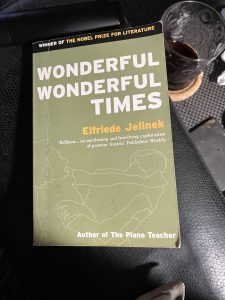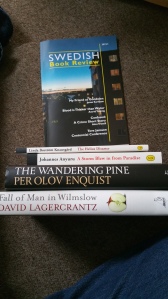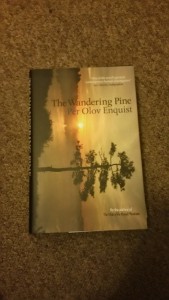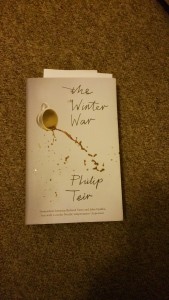Wonderful, Wonderful Times by Elfriede Jelinek
Austrian fiction
Original title – Die Ausgesperrten
Translator – Michael Hulse
Source – Personal copy
I had read this for GermaN Lit Month but I just didn’t get to it in time. This is the second book I had read from the Austrian Nobel lit winner Elfriede Jelinek she is one of those Nobel winners that over time has fade that said I had partly read a non-fiction work the Fitzcarraldo had brought out earlier this year I will finish that at some point. When describing her win the Nobel committee said of her writing. “musical flow of voices and counter-voices in novels and plays that, with extraordinary linguistic zeal, reveal the absurdity of society’s clichés and their subjugating power. This is certainly a book that deals with the cliches of society. It first came out in 1980 and is of that time the period in the post war years it is set in the fifties.
ONE NIGHT AT the end of the fifties an assault is committed in the Vienna municipal park. The following persons all grab hold of one solitary man out walking.
Rainer Maria Witkowski and his twin sister Anna Witkowski, Sophie Pachhofen (formerly von Pachhofen), and Hans Sepp. Rainer Maria Witkowski was named after Rainer Maria Rilke. All of them are about eighteen, Hans Sepp is a year or so older than the others, though he too is without a trace of maturity. Of the two girls, Anna is the more ferocious, which can be seen in the fact that she pays most attention to the face of the subject. Particular courage is required if you are to scratch a man’s face while he is looking full in your own (though he cannot see much since it is dark) or indeed try to scratch his eyes out. For the eyes are the mirror of the soul and ought to remain unscathed if at all possible. Otherwise, people will suppose the soul is done for.
The opening lines open with them grabbing a man
The book happens to deal with the dark side of Austrian society at the time the undercurrents of the post war era. it is the late fifties when a group of four teens attack a man. The four teens are Rainer and Anne who are twins. Their father was in the SS during the war and is now disabled. Hans whose mother is a communist and Sophie an athletic girl(maybe a symbol in some way of Aryanism ?). The book shows the inner working of these teens. Who are just vile and very violent commit crimes? These angst teens are all that happened in Austria before they were born. Now they have been chewed up by the country they are in and have been spat out that they are the dark side of teens. This is a bleak work of teen violence ce lust sex and the past blended together and spat out on the page. Dark kids have a weird connection and love between them. The kids are maybe a symbol for the violence of the past they are like a champagne bottle shaken constantly after the war that undercurrent of the war, nazism, regrets, teen lust and hormones all shaken in the bottle to that single act.
The twins’ unhappiness makes them superior because they have shaken off the shackles and do what they want. Rainer says: people’s lives are predetermined in some way or other, but not mine, I’m superior to them on account of my Will. On the other hand, the individual is free if he wants to be. Rainer avails himself of that freedom, graciously: here he is, being awarded his accreditation certificate. There is a certain heroism in him. In this lonely youth. Lonely in the sense that no one sees him, which halves the value of even the prettiest heroism. Still, at least Rainer can look himself in the face when he’s alone with his mirror.
The twins are the heart off the book here you see the way they look at the world.
There is something about those writers of the post-war era of Austria Bernhard and her with Jelinek. They dived in and tore out the dark heart of the post-war and the past that lingered underneath th country and here it is kids of the rail this is like Holden Caulfield if he had grown up in Germany in love with his sister. This book is dark and complex I saw it describe as Molasses there is something about just the thick rich nature of her writing dark and vile in it tones but wonderfully written. I recently read High Wind in Jamaica another book about kids going off the rails as a group like here it shows how kids can be seen as violent for no reason. Then book like The dinner by Herman Kick another book about kids and violence shows the after math of the act of violence this is a book that connect the two a sort of inner working of the kids caught in the violent acts they are doing. I wish it hadn’t been so long between reading Jelinek’s books she is a unique writer. Have you read any books by Jelinek ?
Winstons score – A the post war embers still burn in the kids of a SS officer.





 The little Communist who never smiled by Lola Lafon
The little Communist who never smiled by Lola Lafon





